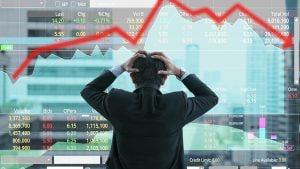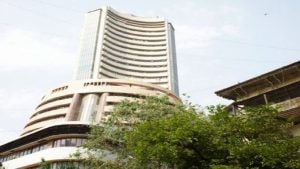Market in final phase of healthy bull market, says Ambit Capital

KV Prasad Jun 13, 2022, 06:35 AM IST (Published)
 Listen to the Article (6 Minutes)
Listen to the Article (6 Minutes)
Summary
Watch full interview of Market veteran Saurabh Mukherjea with CNBC-TV18.
The Indian equity market is in the final phase of a healthy bull market, which could last for another year although the market still looks overvalued, says market veteran Saurabh Mukherjea of Ambit Capital.
The underlying trend still looks good on back of economic recovery, he said adding that it is rare to go into a bear market when the gross domestic product (GDP) is trending up. The economic recovery is supporting the market, he said in an interview to CNBC-TV18.
According to him, the valuations had reached a surreal place and the recent correction has brought in some degree of moderation. However, the market is still 10-15 percent over valued.
Going forward one can expect some degree of FII buying to return as valuations correct.
The only trigger for market weakness is liquidity, be it in the banking system, bond markets or the stock markets. Liquidity is tight and that is putting a pressure on the system even though there is pick up in earnings and the economy.
When asked if he thought the political jitters would impact market sentiment, he said history suggests there is no fundamental link between the two. However, if the markets come off due to political developments, he would see it as a buying opportunity.
Below is the verbatim transcript of the interview.
Sonia: What is the sense you are getting, it has not been a great start to the year, of course we have underperformed most emerging markets, do you think it is our own domestic issues that are dragging us down?
A: I do not think the economy actually is in trouble. I think we have been discussing for the last three or four months on your channel, the economy is recovering quite nicely. I think what happened was valuations ran away into sort of surreal place, especially the first 15-20 days of January, it was quite unbelievable to watch how the market went through the roof. So, a degree of sobering, a degree of moderation was required in valuations.
We have had some of that and I remember a whole bunch of FII meetings early in January where they simply refused to buy Indian stocks because they thought the valuations were outrageous. So now that valuations become a little bit more sensible, I still think the market is 10-15 percent overvalued, but at least valuations are little bit more sensible than they were back in January. I think we will see some degree of FII buying.
The economy is in good shape, valuations are still I think a little too high, but slightly more realistic than we were in the last 15 days of January which was quite unbelievable to watch actually.
Anuj: You reckon that we are putting behind the correction, you always cannot time the market, but broadly somewhere around 10,000 should be the bottom for the market?
A: I am not so sure, so as you are rightly saying, I have got no real view on the short term movement of the market, I have got no ability at all to time the market, but my view is we are still 10-15 percent overdone. So if you ask me, is Sensex 33,000 fair value? I would say Sensex 30,000 is where we should be. Now whether Sensex 30,000 will come next month or next year is anybody’s guess but I think we are still a little too rich on valuations. If you ask me what could be a trigger for the market continuing to see weakness through the summer, I would say it is liquidity.
I think it is reasonably clear that whether it is in our banking system, in the bond market, or in the stock market, liquidity clearly is much tighter now than it was three to five months ago, and that is leading to pressure on the system. We have seen what has happened in the bond market in the last six to seven months and my reckoning is as long as system liquidity stays tight, I think we will have pressure on the stock market even with earnings picking up, even with the economy clearly picking up.
Latha: What will your sector preference be now?
A: We are clearly looking to play what looks like a pretty healthy economic recovery and therefore sectors such as metals and mining which are natural paly on a recovery should do well especially if you continue to get global prices off metals rising.
Second sector I would look at is the CASA funded banks. As bond markets tighten, as bond yields rise, short term money market rates also rise, the NBFCs and HFCs I think will lose ground to the CASA funded banks. So the better quality CASA funded bank franchises I think will become very attractive plays on what looks like an economic recovery.
The third area would be in the six-eight months run up to general elections, I think rural India will do well. It is reasonably clear now, the government said it several times they will spend a great deal on money on rural India in the next seven to eight months. I think somewhere around Rs 2 trillion will probably get spent on food subsidies in FY19 and that should give rural linked stocks a nice fillip.
So those are three sort of tactical plays I would look at. However, beyond that, classic consumer discretionary franchises will continue to do well in our country. I know valuations are steep there, but on legendary franchises with great ROCEs, I would continue to stay invested there.
Sonia: Coming back to that point you made earlier about 30,000 being fair value for the Sensex, what phase of the bull market do you think we are in right now? Is this a mature phase or is this still just a blip in the nascent stage of the Bull Run?
A: I think in the first 15-20 days of January, it looked like we were in the sort of final blaze, final 6 to 12 month blaze of the bull market where the sort of roof gets blown away on valuations and people go berserk. However, I guess that the liquidity tightening has brought a degree of sobering. My reckoning still is that I do not think you are going to suddenly enter a big bear market, my reckoning still is we are in the final phases of what looks like a pretty healthy bull market even to me.
So whilst I still do believe the market 10 percent overvalued, I do believe that there is an overall underlying positive trend to the market which should last for another year, perhaps a couple of years, and your main driver there is a robust economic recovery. Yes, the recovery is factored into the stock market, but it is very rare in our country for the stock market to go into a bear phase when GDP growth is trending up.
I think the GDP growth trend up is central to the bull market continuing and to the extent that on the back of GST rollback, the further farm subsidies this year, the GDP growth trend as well established, I think that will lend the market a lot of support, short term overvaluation notwithstanding.
Anuj: Last year was big one for consumption, discretionary consumption. Autos in particular had a secular rally. We have seen that getting punctured a bit, especially in big names like Maruti Suzuki and TVS Motors though Ashok Leyland is still doing well. Your thoughts on the entire auto pack?
A: I think you need to draw a distinction between auto and auto ancillary. In a good economic recovery, healthy economic recovery, I do not see any reason for the auto OEMs to suffer too much. I think their volume growth numbers will stay very punchy. I think auto ancillary though is headed for a much tougher ride. As inflation goes up, as both commodity price inflation, and generalised CPI inflation goes up, I think auto ancillaries really don’t have the pricing power, never did and probably never will.
Auto ancillaries simply do not have the pricing power to protect their margins and I think that is something that will become a fairly prominent feature of earnings in FY19. Operating margin pressure on smallcap and midcap generally and auto ancillary specifically I think will become more entrenched in FY19. So I think the sector will sort of bifurcate, where OEMs will continue having a decent run, especially on volume growth on earnings, whereas ancillaries I think are headed for choppy waters.
Sonia: You also track the politics of the market very closely. Are you worried about what has been happening across the political landscape and could that sort of create much more jitters in our market as we head into 2019?
A: It is certainly one of the most interesting facet about working in India. There is this sort of enormous obsession about how the stock market and politics are linked. Nothing that I have seen about India’s history over the 10 years that I have spent in the country suggest to me there is any profound link between the stock market and politics really. I know we sort of obsess about it endlessly and every assembly election and obviously general elections there is speculation on what will happen to the government and how it will bear down on the market, I am not so sure there is actually any fundamental link.
Hence if the market comes off this year, if the market comes off nicely this year on the back of a political development as the exit polling season for the general elections begins in the winter, I will see that as a buying opportunity. I am not really in that school which tends to link political results with the stock market. I am aware other investors do, and if investors overreact to political developments, I would see that as a buying opportunity as the year progresses.
Latha: Two external facing sectors, you touched upon metals, but for the last three months our commodities editor has been telling us that metals are ruling at three month lows globally and secondly IT, I did not hear you mention that word.
A: We plugged IT as enthusiastically as we could through the last three months of calendar 2017. I still continue to see the sector as having more juice left in it. I think our currency looks likely to slide quite meaningfully as inflation picks up through the summer, as we store consumption without really fueling investment. I think the Indian currency looks overvalued and over and above that, the American economy looks likely to continue being in fine fettle especially if Trump’s stimulus comes through. So, both as a play on a weakening rupee and as a play on healthy economic recovery in the west, I think IT makes sense.
I would focus on largecap IT stocks, I think even now after the three or four month rally in IT stocks, I think there is still value in the marquee IT franchises in our country. I think the selling got wildly overdone last year and similarly in some of the largecap pharmaceutical stocks. I think there is value in some of the largecap pharmaceutical stocks, I think the pessimism again got overdone there.
I think some of the bigger pharmaceutical names pulled back 40-50 percent last year is quite staggering to watch actually. So, I would have one or two largecap IT stocks, one or two pharmaceutical stocks in my portfolio to give that portfolio stability in what looks likely to be a choppy year from our market perspective and then play the economic recovery with a degree of conviction because if there is one thing you can bank upon in the next 12 months, it is that the Indian economy is headed upwards.

Elon Musk forms several ‘X Holdings’ companies to fund potential Twitter buyout
3 Mins Read
Thursday’s filing dispelled some doubts, though Musk still has work to do. He and his advisers will spend the coming days vetting potential investors for the equity portion of his offer, according to people familiar with the matter

KV Prasad Journo follow politics, process in Parliament and US Congress. Former Congressional APSA-Fulbright Fellow











 Listen to the Article
Listen to the Article  Daily Newsletter
Daily Newsletter









